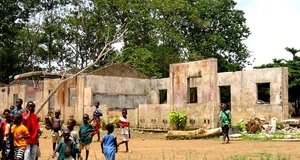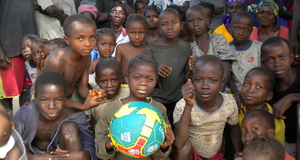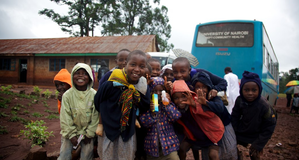Featured Article:The Dead Bodies of the West African Ebola Epidemic: Understanding the Importance of Traditional Burial Practices
By
2015, Vol. 7 No. 11 | pg. 4/4 | « ConclusionMourning and burial traditions that incorporate the use of the corpse are very important in West Africa. The anthropological themes of understanding death as a continual process and as a rite of passage fit well within West African religious philosophy in understanding the mortuary traditions. The main goal of the burial traditions in West Africa is to ensure that the soul of the deceased makes a safe passage to the ancestral world and more importantly, does not find its way back to the living. When the particular rituals are not completed though, the dead body is left in liminal state where it is not yet part of the afterlife but not part of human life either. This liminal period causes much anxiety for the relatives of the deceased who want their loved ones to have a complete transition to the afterlife. Many of the traditional methods of burial are in direct conflict with the recommended policies of health care organizations response to Ebola virus disease because they required the body to be touched, washed, or kissed prior to burial. Though the safe body handling procedures neglect the wishes of the families, they minimize the risk of the spread of the infection. In order to combat the healthcare workers control of the corpses, many families will fight to keep the bodies of their loved ones or get them back after that have been taken. The negative implications of not successfully completing all traditional burial rituals are too high for families to agree to not perform them.Previous anthropological studies about death can really teach a lot to current health care workers and researchers about West African burial rituals. Future research must emphasize bridging the divide between acknowledging that there are important social rituals associated with death versus taking action to lessen the damages from it. In the future, health care workers should work more closely with anthropologists in the field to effectively contain the spread of Ebola virus disease. ReferencesAbramovitch, H. (1999). Good death and bad death. In R. Malkinson, S. Rubin, & E. Witztum (Eds.), Traumatic and Non-traumatic Loss and Bereavement. New York: Psychosocial Press. Bausch, D.G., & Schwarz, L. (2014). Outbreak of ebola virus disease in Guinea: where ecology meets economy. PLOS Neglected Tropical Diseases. 8(7). Beck, J. (2014). Ebola's Territory: A Land Without Human Touch.The Atlantic. Retrieved February 20, 2014 from http://www.theatlantic.com/health/archive/2014/10/ebolas- territory-a-land-withouthuman-touch/381152/ Bloch, M., & Parry, J. (Eds.), (1982). Death and the Regeneration of Life. Cambridge, UK: Cambridge University Press. Bloch, M. (1988). Death and the concept of person. In S. Cederroth, C. Corlin, & J. Lindstrom (Eds.), On the Meaning of Death: Essays on Mortuary Rituals and Eschatological Beliefs. Uppsala, Sweden: Uppsala Studies in Cultural Anthropology, 8. Catedra, M. (1992). Kinds of Death and the House. In Malen, M.A., Death, Mourning, and Burial: A Cross-Cultural Reader. Oxford, UK: Blackwell 77-90. Cooper, H. (2014). Ebola’s Cultural Casualty: Hugs in Hands-On Liberia.The New York Times. Retrieved February 25, 2015, from http://www.nytimes.com/2014/10/05/world/africa/ebolas-cultural-casualty-hugs-in- hands-on-liberia.html?_r=1 Counts, D.A & Counts, D. (2004). The good, the bad, and the unresolved death in Kaliai. Social Science & Medicine. 58, 887-897. Davies, D.J. (2000). Robert Hertz: The Social Triumph Over Death. Mortality. 5(1), 97-102. Fabian, J. (1973). How others die: Reflections on the anthropology of death. In Robben, C.G.M. Antonius (ed.) 2004. Death, mourning and burial: A cross-cultural reader. Oxford, UK: Blackwell 49-61. Faye, O., & Boelle, P. (2015). Chains of transmission and control of Ebola virus disease in Conakry, Guinea, in 2014: An observational study.The Lancet: Infectious Diseases,15(3), 320-326. Retrieved April 10, 2015, from http://www.thelancet.com/journals/laninf/article/PIIS1473-3099(14)71075-8/fulltext Frankfurter, R. (2014). The Danger in Losing Sight of Ebola Victims' Humanity.The Atlantic. Retrieved February 20, 2015 from http://www.theatlantic.com/health/archive/2014/08/the-danger-in-losing-sight-of- ebolavictims-humanity/378945/ Geschiere, P. (2009). The perils of belonging: Autochthony, citizenship, and exclusion in Africa and Europe. Chicago: University of Chicago Press. Hamilton, L. (2015, January 14). Ebola's Hidden Costs.The Atlantic. Goody, J. (2013). Death and the Ancestors: A Study of the Mortuary Customs of the LoDagaa of West Africa. Oxford, UK: Routledge. Hertz R. (1907). Death and The Right Hand. Annee Sociologique. 10, 48–137 [Republished, trans. R Needham, C Needham 1960 Death and the Right Hand.] Hinshaw, D. (2014). In Liberia, Burial Practices Hinder Battle Against Ebola.The Wall Street Journal. Retrieved February 25, 2015 from http://www.wsj.com/articles/in-liberia-burial- practices-hinder-battle-against-ebola-1409619832 Huntingdon, R., & Metcalf, P. (1991). Celebrations of Death: The Anthropology of Mortuary Ritual. (2nd ed.). Cambridge, UK: Cambridge University Press. Irish, D. P., Lundquist K.F., and Nelsen V.J., (eds). (1993). Ethnic variations in dying, death and grief: Diversity in universality. Oxford, UK: Taylor & Francis. Jindra, M. & Joël N., eds. (2013). Funerals in Africa: explorations of a social phenomenon. New York: Berghahn Books. Kaufman, S. R. & Morgan, L. M. (2005). The anthropology of beginnings and ends of life. Annual Review of Anthropology. 34, 317-41. Magesa, L. (1997). African religion: The moral traditions of abundant life. New York: Orbis Books. Malinowski, B. (1939). The group and the individual in functional analysis. American journal of sociology. 44(6). Mbiti, J. S. (1969).African Religions and Philosophy.London, UK: Heinemann Press. Oleribe, O. O. (2015). Ebola virus disease epidemic in West Africa: lessons learned and issues arising from West African countries. Clinical Medicine. 15(1), 54-57. Onishi, N. (2014). For a Liberian Family, Ebola Turns Loving Care Into Deadly Risk. The New York Times. Retrieved February 24, 2015 from http://www.nytimes.com/2014/11/14/world/africa/in-ebola-outbreak-in-liberia-a-familys- strength-can-be-its-fatal- flaw.html?action=click&contentCollection=US%20Open®ion Palgi, P., & Abramovitch, H. (1984). Death: A cross-cultural perspective. Annual Review of Anthropology. 13, 385–417. Pandey, A. (2014). Strategies for containing Ebola in West Africa. Science Magazine. Retrieved February 24, 2015 from http://www.sciencemag.org/content/early/2014/10/29/science.1260612.full.pdf?explicitve rsion=true Parry, J. (1994). Death in Benares. Cambridge, UK: Cambridge University Press. Piot, C. (2010). Nostalgia for the future: West Africa after the Cold War. Chicago: University of Chicago Press. Richards, P., Amara, J., Ferme, M., Kamara, P. (2015). Social pathways for Ebola virus disease in rural Sierra Leone, and some implications for containment. PLOS Neglected Tropical Diseases. Retrieved April 29, 2015 from http://journals.plos.org/plosntds/article?id=10.1371/journal.pntd.0003567 Rosaldo, R. (1989). Grief and a headhunter’s rage. In Robben, C.G.M. Antonius (ed.) 2004. Death, mourning and burial: A cross cultural reader. Oxford, UK: Blackwell 167-178. Scheper-Hughes, N. (1992). Death Without Weeping: The Violence of Everyday Life in Brazil. Los Angeles: University of California Press. Sharp, L. A. (2007). Bodies, Commodities, and Biotechnologies: Death, Mourning, and Scientific Desire in the Realm of Human Organ Transfer. New York: Columbia University Press. Shittu, R.O., Sanni, M.A., Odiegha, L.O. (2015) Awareness, Knowledge and Misconceptions about Ebola Virus Disease (EVD) in a Family Practice Setting in Nigeria, West Africa. Journal of Antivirals and Antiretrovirals. 7(1), 10-14. Tempels, P. (1959).Bantu Philosophy.Paris, FR: Présence Africaine. Turner, V. (1964). Betwixt and between: The liminal period in the rites of passage. The proceedings of the American Ethnological society: Symposium on new approached to the study of religion. 4-20. Turner, V. (1969). The Ritual Process: Structure and Antistructure. Chicago: Aldine Publishing Corporation. Van Gennep, A. (1960). The Rites of Passage. London, UK: Routledge and Kegan Paul Limited. Wagner, S. (2013). The making and unmaking of an unknown soldier. Social Studies of Science. 43(5), 631-636. Vogt, H. (2014). Some Ebola-Stricken African Families Pay Bribes for Fake Death Records. Wall Street Journal. Retrieved February 24, 2015 from http://online.wsj.com/articles/some-ebola-stricken-african-families-pay-bribes-for-fake- death-records-1413153854 Wolz, A. (2013). Face to face with Ebola—an emergency care center in Sierra Leone. New England Journal of Medicine. 371(12), 1081-1083. World Health Organization Ebola Situation Report. (2015). World Health Organization. Retrieved September 16, 2015 from http://apps.who.int/ebola/current-situation/ebola- situation-report-16-september-2015 World Health Organization Safe Burial Practices. (2015). World Health Organization. Retrieved April 20, 2015 from http://www.who.int/features/2014/ebola-survivor-stories/en/ World Health Organization Stories of Ebola Survivors. (2015). World Health Organization. Retrieved April 20, 2015 from http://www.who.int/features/2014/ebola-survivor- stories/en/ Suggested Reading from Inquiries Journal
Inquiries Journal provides undergraduate and graduate students around the world a platform for the wide dissemination of academic work over a range of core disciplines. Representing the work of students from hundreds of institutions around the globe, Inquiries Journal's large database of academic articles is completely free. Learn more | Blog | Submit Latest in Anthropology |
















